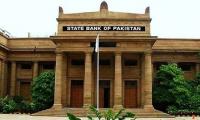ISLAMABAD: Amid the emerging differences over the GDP growth estimates at the initial stage, the National Accounts Committee has reconciled figures and announced that Pakistan’s provisional growth rate stood at 3.94 percent for the outgoing fiscal year against the fixed target of 2.1 percent.
The overall size of Pakistan’s economy in dollar terms has gone up to $296 billion in 2020-21 against $263 billion in the last financial year 2019-20. It shows that the size of the economy in dollar terms increased by $33 billion during the current fiscal year. The per capita income has gone up to $1,543 in the outgoing fiscal year.
Overall, the GDP growth rate remained on average 1.75 percent in the last three-year rule of PTI led government against a population growth rate of 2.1 percent per annum basis, so the per capita income in real term nosedived on average in the last three years. '
Prime Minister Imran Khan said in a tweet “this reflects the success of our govt's economic policies while managing COVID 19 pandemic. Our V-shaped recovery is balanced between 3 major sectors: agriculture, industry & services.”
Federal Minister for Planning Asad Umar tweeted that the National Accounts Committee had finalised the GDP growth estimates. "Alhamdulillah, the GDP growth has come in at 3.94 percent This growth in a period in which COVID placed a huge challenge to the economy is extremely gratifying and proof of the success of Imran Khan and PTI." He said that due to a combination of GDP growth and strengthening of Pak Rupee against US dollar, per capita income of Pakistan jumped up by 13.4 percent this year from $1,361 to $1,543. Total GDP increase from $263 billion to $296 billion, an increase of $33 billion which is the highest ever increase in any year.
Federal Minister Hammad Azhar tweeted that the GDP growth was estimated close to 4 percent. “This is a remarkable recovery & unlike past growth stints, forex reserves have also grown and the current account remains in surplus. Industry-led this growth estimated close to 4 percent”, he added.
When the National Accounts Committee (NAC) kick-started its deliberations here on Friday at the Planning Commission’s Auditorium, there was a huge difference between provisional Gross Domestic Product (GDP) growth rate estimates tabled by the Pakistan Bureau of Statistics (PBS) in its working paper and the State Bank of Pakistan. The SBP, through its model, had calculated the GDP growth rate estimated at 3 percent while the PBS in its working paper estimated a growth rate of 3.94 percent for the outgoing the fiscal year 2020-21.
The Secretary Planning constituted a high-powered committee comprising officials belonging to the Planning Ministry, Ministry of Finance, SBP, and PBS with the mandate to reconcile the GDP growth figures till 3pm Friday and finally this committee sorted out the differences amicably.
When the committee scrutinized all sectors contributing to the national economy, it found that the SBP had taken wheat production estimates of 26.2 million tons but the PBS had taken higher production of wheat as the crop reporting of provinces had given figures of 27.2 million tons. The SBP representative agreed to the provisional GDP growth figure of 3.94 percent.
Interestingly, there was a marginal change in the revised figures of the last fiscal year as the finalized GDP growth for 2019-20 stood at negative 0.47 percent against provisional GDP growth figure of -0.38 percent. The National Accounts Committee also gave the GDP growth rate of 2.08 percent for 2018-19 from earlier figure of 1.9 percent. The GDP growth figure for 2018-19 was revised downward from 3.3 percent provisional figure to 1.9 percent in finalized figures and it had invited severe criticism after witnessing such a massive revision.
There was pressure on the PBS in the last fiscal year from former Finance Minister Dr Abdul Hafeez Shaikh who had argued that the IMF/World Bank was projecting GDP growth rate at negative 1.5 percent and there was no way it stood at negative 0.4 percent. However, Federal Minister for Planning Asad Umar had defended the PBS in meeting in front of PM, saying that he had checked the data and the PBS figures would prove correct in revised estimates.
For the ongoing fiscal year, the IMF/World Bank and Asian Development Bank had projected the GDP growth rate in the range of 1.5 to 2 percent but the SBP had revised upward its projection for GDP growth at 3 percent. Now with revised estimates of agriculture growth mainly because of improved wheat production, services sector growth, retail and wholesale trade and manufacturing sector, the GDP growth rebounded and stood at 3.94 percent.
Independent economists argued that the government must fix the GDP growth rate at 4 percent for the next budget 2021-22 because the revised GDP growth for the current fiscal year might go up and would be standing between 4.7 percent to 5 percent because the Large Scale Manufacturing (LSM) growth would be hovering around 70 percent for April 2021. The overall LSM growth on average will be standing at 13.5 to 14 percent, so it will pull up the GDP growth to 4.7 to 5 percent in revised figures for 2020-21 because of the low base effect. The next year growth target should be fixed at around 4 percent because there will be a higher base effect.
When contacted, Pakistan’s renowned economist Dr. Ashfaque Hasan Khan said that it was a positive surprise for him hearing about the GDP growth rate of 3.94 percent as he was expecting growth rate of 3 percent for the current fiscal year. He said that it was also a surprise for the Ministry of Finance and State Bank of Pakistan. He said that the growth rate was contributed by agriculture, retail and wholesale trade and large scale manufacturing for the current fiscal year.
According to an official announcement made here on Friday, the 103rd meeting of the National Accounts Committee to review the Gross Domestic Product (GDP) was held under the chairmanship of the Secretary Ministry of Planning, Development and Special Initiatives. The provisional estimates of the GDP and Gross Fixed Capital Formation (GFCF) for the year 2020-21 were presented on the basis of the latest data of 6-9 months which were annualized.
The provisional growth of GDP for the year 2020-21 has been estimated at 3.94%, which is based upon growth estimates of the agricultural, industrial, and services sectors at 2.77%, 3.57%, and 4.43%, respectively. The growth for 2019-20 was revised downward from -0.38% to -0.47%.
Agricultural Sector: The agriculture sector grew by 2.77% in 2020-21 as against 3.31% in 2019-20. The growth of important crops during this year is 4.65% on the back of the historic highest-ever production of wheat, rice, and maize while sugarcane registered the second-highest ever production. This growth in the production of wheat, rice, sugarcane, and maize is at 8.1%, 13.6%, 22.0%, and 7.38%, respectively. However, cotton has witnessed negative growth of 22.8%, which also resulted in a 15.6% decline in cotton ginning. Other crops (vegetables, fruits and green fodder, etc.) showed positive growth of 1.41% mainly because of an increase in the production of oil seeds and vegetables. The livestock sector registered a growth of 3.1%. Forestry has grown at 1.4%.
Industrial Sector: The overall industrial sector has witnessed a positive growth of 3.57%. The value-added in the mining and quarrying sector has declined by 6.5%. The large-scale manufacturing (LSM) sector, which is driven primarily by QIM data (from July 2020 to March 2021), showed an unprecedented healthy growth of 9.29%. Major contributors to this growth are Textile (5.9%), Food Beverage & Tobacco (11.73%), Petroleum products (12.71%), Pharmaceuticals (12.57%), Chemicals (11.65%), Non-Metallic Mineral Products (24.31%), Automobiles (23.38%), and Fertilizer (5.69%). The electricity and gas sub-sector has declined by 22.96% mainly due to lower allocation of subsidies by the government to DISCOs, low increase in output, and a higher proportional increase in intermediate consumption. The construction activity has increased by 8.34% mainly due to an increase in general government expenditure and private sector construction-related expenditures.
Services Sector: Services sector remained a major growth driver for many years and this year it witnessed a growth of 4.43% in the provisional estimates. While the wholesale and retail trade sector grew by 8.37% primarily because of an increase in the marketable surplus, the transport, storage, and communication sector has declined by 0.61%. The finance and insurance sector showed an increase of 7.84%. The remaining components of services i.e. housing, general government, and other private services have witnessed a positive growth of 4.01%, 2.20%, and 4.64%, respectively.
The GDP at Current Market Prices: GDP at current market prices has also been computed and stands at Rs.47,709 billion for 2020-21. This shows a growth of 14.8% over Rs41,556 billion for 2019-20. The per capita income for 2020-21 has been calculated as Rs246,414, showing a growth of 14.6% over Rs215,060 during 2019-20. The per capita income in dollars increased by 13.4% from USD1,361 in 2019-20 to USD1,543 in 2020-21.
Distribution took place in camp in district Hangu, providing timely relief to displaced families in need
Western countries call for united front in support for Ukraine, saying no decisions could be taken without Ukraine’s...
ATC orders Gandapur to appear by January 21, 2025, failing which he will be declared proclaimed offender
Circular says authority decided to invite applications from SC advocates who desire to be included in panel
Jet was en route from country’s capital Baku to city of Grozny in Chechnya, southern Russia
Pension of retired chief justices and judges of SCP has also been revised with increase in their monthly pension







